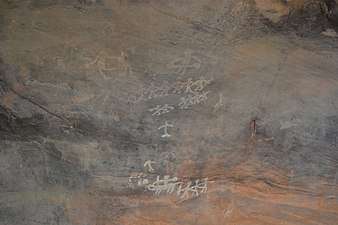Sadan people
Sadan are the Indo-Aryan-speaking ethnolinguistic groups of Jharkhand and neighbouring states who speak Nagpuri, Khortha, Panchpargania and Kurmali language as their native language.[1][2][3][4]
| Languages | |
|---|---|
| Nagpuri •Khortha• Panchpargania •Kurmali | |
| Religion | |
| Predominantly: Minorities: | |
| Related ethnic groups | |
| Indo-Aryan peoples |
Etymology
Sadan refers to non-tribal Indo-Aryan ethnic groups of Jharkhand. The term Sadan probably derives from Nishada, referring to an ethnic group of North India.[1]
History

The Chota Nagpur plateau region has been inhabited since the Neolithic period. Several stone tools and microliths from the Mesolithic and Neolithic periods were discovered in this region.[5] In the Bhimbetka rock shelters, a 9,000-year-old Mesolithic painting of a group dance is similar to the Sadani folk dance Jhumair.
During the Neolithic period, agriculture started in South Asia. Several Neolithic settlements have been found in sites such as Jhusi, Lahuradewa, Mehergarh, Bhirrana, Rakhigarhi, and Chirand. In the Kabra-Kala mound at the confluence of the Son and North Koel rivers in Palamu district, various antiquities and art objects from the Neolithic to medieval periods have been found; the pot-sherds of redware, black and red ware, black ware, black slipped ware, and NBP ware are from the Chalcolithic to late medieval periods.[6] There are ancient cave paintings in Isko, Hazaribagh district, from the Meso-chalcolithic period (9,000-5,000 BC).[7] Iron slag, microliths, and potsherds from 1400 BCE, according to carbon dating, were discovered in Singhbhum district.[8] During the late Vedic period, several janapadas emerged in northern India. Several Nishada kingdoms probably existed in Jharkhand during that time. In the 6th century BCE, the mahajanapadas emerged in several parts of the Indian subcontinent. Some parts of present-day Jharkhand were parts of the Magadha and Anga mahajanapadas.
In the Mauryan period, this region was ruled by a number of states, collectively known as the Atavika (forest) states. These states accepted the suzerainty of the Maurya empire during Ashoka's reign (c. 232 BCE). During the medieval period, the Nagvanshi, Ramgarh Raj, and Chero dynasties were ruling this region. The Mughal influence reached this area during the reign of Emperor Akbar when it was invaded by Raja Mansingh in 1574. There was several invasion during Mughal rule.[9] Influence of the British East India Company reached this region in the 18th century. Raghunath Mahato led a revolt against the East India company in the Jungle Mahals in 1769. Thakur Vishwanath Shahdeo and Pandey Ganpat Rai led rebels against the East India company in the 1857 Rebellion. Tikait Umrao Singh, Sheikh Bhikhari, Nadir Ali, Jai Mangal Singh played pivotal role in Indian Rebellion of 1857.[10]
After independence this region became parts of Bihar state. In November 2000, the new state of Jharkhand separated from Bihar.
Castes and ethnic groups
Various Sadan communities include Ahir, Binjhia, Bhogta, Bhuiya, Chik Baraik, Gosain, Ghasi, Jhora, Kewat, Kharwar,[11] Koeri, Kumhar, Rautia, Kudumi Mahato, Kurmi, Lohra, Tanti , Teli, Rajput, Bania and Lohar among others.[12]
Culture
Jhumair is a common folk dance of Sadan. Chhau is another folk dance prevalent in the Kurmali-speaking region. Akhara is a village ground where people dance. The Karam and Jitia are important festivals of the Sadan.[13] Other important festivals are Sohrai, Tussu, and Fagua.
Notable people
- Jay Prakash Singh Bhogta
- Satyanand Bhogta
- Chandra Prakash Choudhary
- Ram Tahal Choudhary
- Ganesh Ganjhu
- Deepika Kumari
- Deepak Lohar
- Binod Bihari Mahato
- Dhananjay Mahato
- Loknath Mahto
- Purnima Mahato
- Raghunath Mahato
- Nirmal Mahto
- Sudesh Mahto
- Tek Lal Mahto
- Mukund Nayak
- Nikki Pradhan
- Dhiraj Prasad Sahu
- Shiv Prasad Sahu
- Durjan Sal
- Bakhtar Say
- Raghunath Shah
- Lal Chintamani Sharan Nath Shahdeo
- Lal Pingley Nath Shahdeo
- Lal Ranvijay Nath Shahdeo
- Thakur Vishwanath Shahdeo
- Basant Narain Singh
- Dalel Singh
- Kamakhya Narain Singh
- Madhu Singh
- Mundal Singh
- Tikait Umrao Singh
Notes
References
- "Sadani / Sadri". Southasiabibliography.de. Retrieved 17 February 2019.
- Remapping India: New States and their Political Origins. books.google.com. Retrieved 22 August 2019.
- Issues in Indian Politics. books.google.com. Retrieved 22 August 2019.
- "JHARKHAND: March To Extreme Tribalism?". www.southasiaanalysis.org. Retrieved 23 April 2019.
- periods, India-Pre- historic and Proto-historic (4 November 2016). "India – Pre- historic and Proto-historic periods". Publications Division Ministry of Information & Broadcasting. Retrieved 17 February 2019 – via Google Books.
- "KABRA – KALA". www.asiranchi.org.
- "Cave paintings lie in neglect". The Telegraph. 13 March 2008.
- Singh, Upinder (8 September 2018). "A History of Ancient and Early Medieval India: From the Stone Age to the 12th Century". Pearson Education India. Retrieved 17 February 2019 – via Google Books.
- "History". Latehar.nic.in.
- "JPCC remembers freedom fighters Tikait Umrao Singh, Sheikh Bhikari". news.webindia123.com.
- "Kanwar" (PDF). shodhganga.inflibnet.ac.in.
- "1 Paper for 3 rd SCONLI 2008 (JNU, New Delhi) Comparative study of Nagpuri Spoken by Chik-Baraik & Oraon's of Jharkhand Sunil Baraik Senior Research Fellow". slideplayer.com.
- "talk on nagpuri folk music at ignca". daily Pioneer.com.